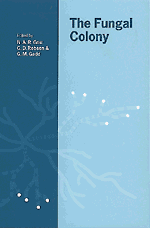Book contents
- Frontmatter
- Contents
- List of contributors
- Preface
- 1 Self-integration – an emerging concept from the fungal mycelium
- 2 Nutrient translocation and electrical signalling in mycelia
- 3 Colony development in nutritionally heterogeneous enviromnents
- 4 Circadian rhythms in filamentous fungi
- 5 Growth, branching and enzyme production by filamentous fungi in submerged culture
- 6 Metabolism and hyphal differentiation in large basidiomycete colonies
- 7 Role of phosphoinositides and inositol phosphates in the regulation of mycelial branching
- 8 Stress responses of fungal colonies towards toxic metals
- 9 Cellularization in Aspergillus nidulans
- 10 Genetic control of polarized growth and branching in filamentous fungi
- 11 Mating and sexual interactions in fungal mycelia
- 12 Genetic stability in fungal mycelia
- 13 Nuclear distribution and gene expression in the secondary mycelium of Schizophyllum commune
- Index
Preface
Published online by Cambridge University Press: 22 January 2010
- Frontmatter
- Contents
- List of contributors
- Preface
- 1 Self-integration – an emerging concept from the fungal mycelium
- 2 Nutrient translocation and electrical signalling in mycelia
- 3 Colony development in nutritionally heterogeneous enviromnents
- 4 Circadian rhythms in filamentous fungi
- 5 Growth, branching and enzyme production by filamentous fungi in submerged culture
- 6 Metabolism and hyphal differentiation in large basidiomycete colonies
- 7 Role of phosphoinositides and inositol phosphates in the regulation of mycelial branching
- 8 Stress responses of fungal colonies towards toxic metals
- 9 Cellularization in Aspergillus nidulans
- 10 Genetic control of polarized growth and branching in filamentous fungi
- 11 Mating and sexual interactions in fungal mycelia
- 12 Genetic stability in fungal mycelia
- 13 Nuclear distribution and gene expression in the secondary mycelium of Schizophyllum commune
- Index
Summary
Fungi are amongst the simplest of eukaryotes and have become useful paradigms for processes that are fundamental to the way in which higher cells grow, divide, establish for-m and shape and communicate with one another. Leading the way has been the budding yeast Saccharomy cescerevisiae whom ease of manipulation and accessible systems for sexual and molecular genetics have spearheaded basic investigations into fundamental processes as diverse as the analysis of the cell cycle, to investigations of longevity. Although unicellular fungi are greatly outnumbered in nature by the moulds our knowledge of them is much less developed than in this single yeast species. The true hallmark of the filamentous fungus is the hypha – tubular tip-growing cells that are the constituent components of the fungal mycelial colony. This work is dedicated to the analysis of the filamentous life style of fungi, the elaboration of the branching mycelium and the interactions between fungal mycelia. Mycelial fungi also offer major and exciting opportunities for cell and developmental biologists, physiologists, biochemists and developmental biologists. For example, the fungal hypha and the branching mycelium is an excellent system in which to explore the regulation of polarized cell growth, intracellular transport and how nuclei interact within a common cytoplasm, how genetically similar and dissimilar species interact and recognize one another and how growth responses can be coordinated as an organism explores and infiltrates a heterogeneous environment. These themes form the rationale for this work.
- Type
- Chapter
- Information
- The Fungal Colony , pp. ix - xPublisher: Cambridge University PressPrint publication year: 1999

